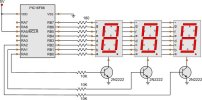Things are getting a little bit more complicated here. We want to have three different 7-seg that each one will show a different number. Normally, we would need 7 pins for each one, so a total of 21 pins are required, right? No, because in that way, if we wanted to have 6 digits (for a frequency meter for example) we would need 42 pins! Instead, we will make a trick, a trick with the eye. The catch is that the human eye does not operate non-stop all the time. Instead, it takes 10 'photos' each second. Between those photos, the brain will keep the last photo taken active, something like a 'latch'. We will take advantage of this characteristic for this circuit.
The circuit
here is the circuit of this tutorial:

As you can see, we only use the 8 lines from PORTB for the segments (7 segments + one for the dot) and three more lines, RA0, RA1 and RA2 for the drive-lines for the displays. All digit segments are connected in parallel using only one set of limiting resistors. The common-cathode pin of each display is not connected directly to ground. Instead, a 2N2222 transistor is connected between and used as a switching transistor.
Only one display is active at a time and it remains active for about 4mSec. Then this display is turned off and the next one is active for 4mSec. Because the displays are turned on and off very quickly, the eye will be tricked. The numbers will appear as if they are illuminated all the time.
With this way, you can easily have many 7-seg displays connected using the 7 (or 8) pins for the segments and one extra pin for each additional display. The turn-on time that i have chosen is 4 mSec but you may need to reduce this time in case of more digits. Do not make it too small though. You can use a lower-value limiting resistor for the segments as long as the current does not excess 25mA.
The Code
Here is the code for lighting the displays:
The project Files
Following are the files for this project:
The circuit
here is the circuit of this tutorial:

As you can see, we only use the 8 lines from PORTB for the segments (7 segments + one for the dot) and three more lines, RA0, RA1 and RA2 for the drive-lines for the displays. All digit segments are connected in parallel using only one set of limiting resistors. The common-cathode pin of each display is not connected directly to ground. Instead, a 2N2222 transistor is connected between and used as a switching transistor.
Only one display is active at a time and it remains active for about 4mSec. Then this display is turned off and the next one is active for 4mSec. Because the displays are turned on and off very quickly, the eye will be tricked. The numbers will appear as if they are illuminated all the time.
With this way, you can easily have many 7-seg displays connected using the 7 (or 8) pins for the segments and one extra pin for each additional display. The turn-on time that i have chosen is 4 mSec but you may need to reduce this time in case of more digits. Do not make it too small though. You can use a lower-value limiting resistor for the segments as long as the current does not excess 25mA.
The Code
Here is the code for lighting the displays:
Kod:
; Definitions -------------------------------------------------------------
#define Left_Seg porta,0
#define Mid_Seg porta,1
#define Right_Seg porta,2
#define Segments portb
; Main Program ------------------------------------------------------------
Start
bank1 ;Go to bank 1
movlw b'11111000' ;
movwf TRISA ;Set the port pin types of the RA
movlw b'00000000' ;
movwf TRISB ;Set the port pin types of the RB
bank0 ;Go to bank 0
MainLoop
call HideAllSegments
movlw b'00000110' ;Number 1
movwf Segments
call ShowLeftSegment
call HideAllSegments
movlw b'01011011' ;Number 2
movwf PORTB
call ShowMiddleSegment
call HideAllSegments
movlw b'01001111' ;Number 3
movwf PORTB
call ShowRightSegment
goto MainLoop
HideAllSegments
bcf Left_Seg
bcf Mid_Seg
bcf Right_Seg
return
ShowLeftSegment
bsf Left_Seg
call Wait4mSec
return
ShowMiddleSegment
bsf Mid_Seg
call Wait4mSec
return
ShowRightSegment
bsf Right_Seg
call Wait4mSec
returnThe project Files
Following are the files for this project:
